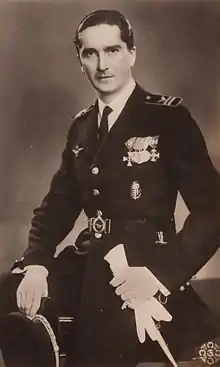István Horthy
István Horthy de Nagybánya (9 December 1904 – 20 August 1942) was Hungarian Regent Admiral Miklós Horthy's eldest son, a politician, and, during World War II, a fighter pilot.
István Horthy de Nagybánya | |
|---|---|
 | |
| Deputy Regent of Hungary | |
| In office 19 February 1942 – 20 August 1942 | |
| Monarch | vacant |
| Leader | Miklós Horthy as Regent |
| Preceded by | position established |
| Succeeded by | position vacant |
| Personal details | |
| Born | István Horthy de Nagybánya 9 December 1904 Pola, Austria-Hungary (today Pula, Croatia) |
| Died | 20 August 1942 (aged 37) Alexeyevsky District, Russian SFSR |
| Political party | Independent |
Biography
In his youth, István Horthy and his younger brother Miklós Jr. were active members of a Catholic Scout troop of the Hungarian Scout Association (Magyar Cserkészszövetség), although he was a Protestant.[1] Horthy graduated as a mechanical engineer in 1928. He went to the United States for one year and worked in the Ford factory in Detroit, Michigan.
Returning to the Kingdom of Hungary, he worked in MÁVAG's locomotive factory in this occupation. On the forefront of the designer team, he took part in the development of many great projects, such as the Locomotive 424. Between 1934 and 1938, Horthy was director of the company and after 1938 he became its general manager. In 1940, he married Countess Ilona Edelsheim-Gyulai. He strenuously confronted Nazism, and often made his criticism public. In January 1942, he has been elected Deputy Regent, and for some time, the "small regent" enjoyed massive popularity in Hungary. Shortly thereafter, István was sent to the Eastern Front. His humanity, and his disagreement in the "Jewish Question" appears even here, too – a quote from one of his letters, which he sent to his father from Kiev: "[...] Yet another sad topic: the Jewish companies, as I hear, -there 20 or 30 000 [men]-, are at the mercy of the sadist's passions, in every regard; the stomach of man gets ache [looking at this]; it is abhorrent, that in the 20th century, it happens at us, too... [...] I fear, we will pay for this very dearly once. (Is it possible to take them home to work there?) Otherwise, in spring, only a few will be alive. [...]"[2]
István Horthy died in Russia, shortly after his arrival,[3] in a much publicized flying accident. He was then serving in Royal Hungarian Air Force (Magyar Királyi Honvéd Légierő), MKHL, with the rank of 1/Lt, as a fighter pilot. His unit, 1/3 Fighter Squadron, was supporting the Hungarian Second Army against Soviet forces. He was flying his MÁVAG Héja ("Hawk"), V.421, a Hungarian fighter based on the Italian Reggiane Re.2000. During his 25th operational sortie, soon after takeoff from an air field near Ilovskoye, the other pilot, flying with him, asked Horthy to increase height. István pulled up rapidly. His aircraft (that had become much more prone to stalls, after a steel plate was added behind the cockpit of all Reggianes, to protect pilots, but so shifting the plane's center of gravity) stalled and crashed.[4] It was 20 August 1942 (18 August, according to other authors [5]).
His only son, Sharif István Horthy, is a successful engineer.
Honors
Postage stamp: István Horthy was honored by Hungary by issuing a commemorative postage stamp on 15 October 1942.[6]
References
- Notes
- John S. Wilson: Scouting Round the World, first edition, London, Blandford Press, 1959, 81.
- Ilona Edelsheim-Gyulai: Becsület és kötelesség, part I. Budapest, Európa press, 2001.
- Time Magazine, Monday, 31 August 1941, Milestones
- Neulen 2000, p. 127.
- Punka 2002, p. 9.
- colnect.com/en/stamps/stamp/179998-István_Horthy_son_of_Miklós_Horthy-People-Hungary
- Bibliography
